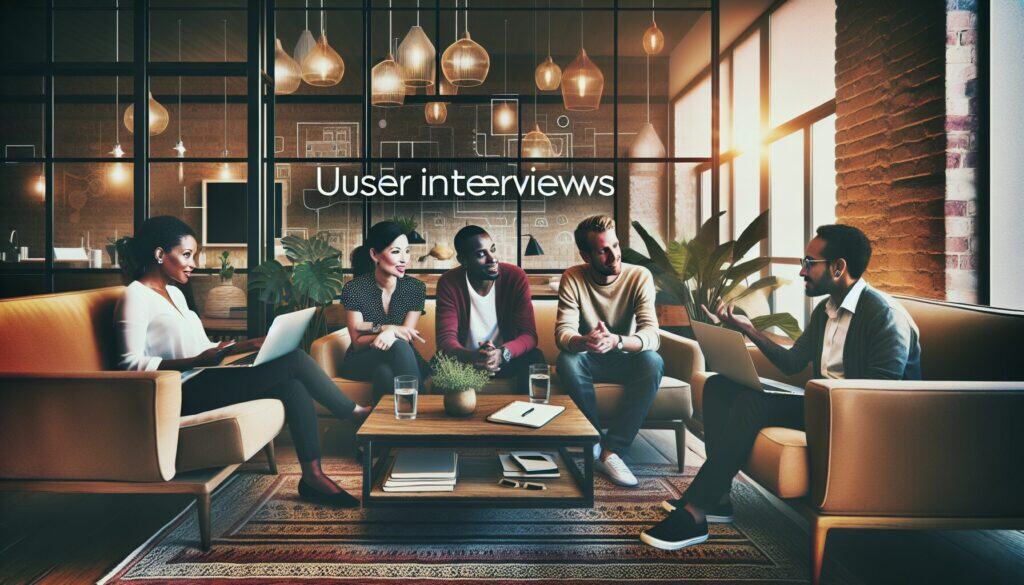To gain deep, qualitative insights into users’ experiences, motivations, needs, pain points, and context regarding a product or service.
- Metodologías: Ergonomía
User Interviews

User Interviews
- Experiencia del cliente, Trayectoria del cliente, Pensamiento de diseño, Validación del diseño, Diseño centrado en el ser humano, Usabilidad, Pruebas de usabilidad, Experiencia de usuario (UX), Diseño centrado en el usuario
Objetivo:
Cómo se utiliza:
- A one-on-one conversation where a researcher asks open-ended questions to a participant representing the target user group. Sessions are often recorded and involve active listening and probing to uncover detailed information.
Ventajas
- Provides rich, in-depth understanding of user perspectives; Uncovers the "why" behind user actions; Builds empathy for users; Flexible to explore unexpected topics.
Contras
- Time-consuming to conduct and analyze; Results are qualitative and not statistically generalizable; Potential for interviewer bias; Can be expensive if recruiting many participants.
Categorías:
- Clientes y marketing, Ideación, Diseño de producto
Ideal para:
- Understanding user needs, validating concepts, and gathering detailed feedback on usability and desirability.
User interviews play a significant role during the early phases of product design and development, especially in industries such as software, consumer goods, healthcare, and automotive, where understanding end-user behavior is paramount. The methodology usually involves various stakeholders including product managers, UX designers, and researchers, who work collaboratively to formulate open-ended questions that delve deep into user experiences. These sessions can occur in diverse settings, from informal coffee chats to structured environments, and they are typically recorded for accuracy. Insights harvested from these discussions can inform iterative design processes, contribute to usability testing, and assist in identifying pain points or unmet needs that quantitative data alone may not reveal. For instance, user interviews have been instrumental in guiding the design of navigating interfaces in mobile applications, allowing teams to uncover specific frustrations that users may experience in terms of layout, functionality, and overall accessibility. This qualitative data serves not only to validate hypotheses but also to drive innovation by sparking new ideas based on firsthand user experiences. As a flexible method, these interviews can pivot according to participant responses, uncovering unexpected areas of interest that might lead to breakthrough concepts. Engaging with actual users allows design teams to cultivate empathy, ensuring that the final product aligns closely with user expectations and enhances satisfaction. This methodology proves to be particularly effective in iterative design cycles, where repeated insights can lead to continuous improvements until the product reaches market readiness. Conducting user interviews early and frequently can also establish a strong foundation for user-centered designs, attracting broader market acceptance upon launch.
Pasos clave de esta metodología
- Begin the session with a warm introduction to establish rapport.
- Ask open-ended questions to encourage participants to share their thoughts freely.
- Employ active listening techniques, such as nodding and verbal affirmations.
- Use follow-up questions and probes to delve deeper into specific responses.
- Pay attention to non-verbal cues and body language for additional context.
- Prompt participants to elaborate on their experiences and feelings.
- Encourage storytelling to capture detailed user experiences and motivations.
- Allow for pauses and silence to give participants time to think and respond.
- Summarize key points during the interview to check understanding and verify accuracy.
- End the session by thanking participants and reiterating the value of their input.
Consejos profesionales
- Incorporate ethnographic techniques by observing users in their natural environment before interviews to contextualize findings.
- Utilize thematic analysis post-interview to identify patterns across multiple sessions, enhancing synthesis of qualitative data.
- Employ cognitive walkthroughs to complement interviews, allowing users to verbalize their thought processes as they interact with prototypes.
Leer y comparar varias metodologías, recomendamos el
> Amplio repositorio de metodologías <
junto con otras más de 400 metodologías.
Sus comentarios sobre esta metodología o información adicional son bienvenidos en la dirección sección de comentarios ↓ , así como cualquier idea o enlace relacionado con la ingeniería.
Contexto histórico
1986
(si se desconoce la fecha o no es relevante, por ejemplo "mecánica de fluidos", se ofrece una estimación redondeada de su notable aparición)

Publicaciones relacionadas
Cuestionarios sobre molestias musculoesqueléticas
Pruebas multivariantes (MVT)
Análisis de regresión múltiple
Sistemas de captura de movimiento
Método MoSCoW
Prueba de la mediana de Mood